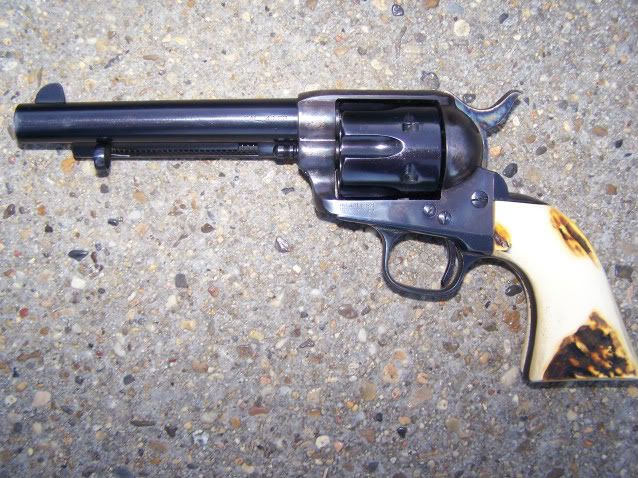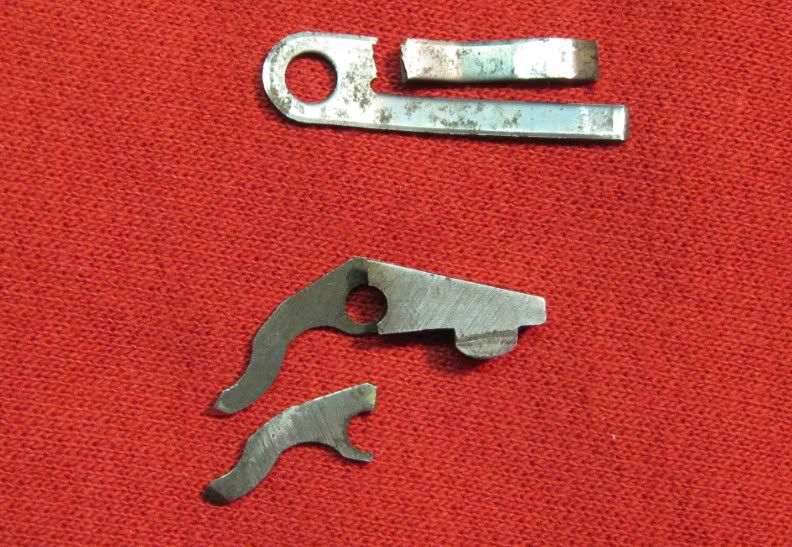Howdy
Curious as to where you got that date of 1875 regarding 5 1/2" barrels?
The best I have been able to come up with is that barrels other than 7 1/2" were relatively rare for early Colts. Kopec makes reference to a shipment to a dealer in London which lists some 5 1/2" barreled models, but he also says, 'in this chapter's serial number range (1-30000), original barrels shorter than 7 1/2 inches are unusual'. As far as I know, the 5 1/2' barrel became popular with the so called 'Artillery Models'. Artillery Model is a collector's term, not an official Colt designation. During the period from about 1895-1903 a number of well worn 7 1/2" military Colts that had been in use by the Army for some 20 years were returned to the Colt factory and the Springfield Armory for refurbishing. Because of extreme wear at the muzzle, many of these guns had their 7 1/2" barrels cut down to 5 1/2". Many of these newly refurbished guns, most of which had mismatched parts, were issued to artillery units, hence the name. Coincidentally, many of these guns saw use in Cuba during the Spanish American War.
******************
Don't get too hung up on this business of buying 'total 100% authenticity to a true early version SAA'. The last thing you want to do is to be proudly showing off your new purchase to one of your pals at the range, and have him inform you that some particular feature is incorrect for the date you are trying to portray. You might want to buy a few books and read up about the old Colts, rather than relying on what you may find on the internet. That applies to my advice too. Another great source of information is attending a large gunshow where collectors have some originals for sale. Many true collectors are very friendly and do not mind you handling their treasures. Of course, ask permission before you cock the hammer, and NEVER drop the hammer on an antique that does not belong to you. Handling the originals and asking questions is a great way to start to understand some of the subtle differences between the originals and the current replicas.
The truth is, the SAA underwent numerous minor design changes almost from Day One, so being 100% authentic to the originals is just about impossible. Nobody is producing a copy of the early 'pinched frame' Colts today. USFA used to make one, but they are no longer in the business of making replicas of the SAA. Nobody is producing any replicas today with the early conical style firing pin, the 1st Generation cylinder ratchet teeth shape or the hand style that went with it, which would have been in the early gun you are seeking to replicate. Another thing to check out is a lot of the imports are being made today with a coil spring and plunger for the hand, instead of the original leaf type spring. The coil spring sits in the left screw hole next to the hammer, underneath the grip screw. The old leaf style hand spring was one of the springs that often broke on a SAA, so many modern replicas are being made with the coil spring today. And no, you cannot substitute a leaf spring for the coil spring, without cutting a slot into the hand to receive the spring.
Regarding the hammer block safety or the double groove cylinder pin, it is a requirement of the US government that single action revolvers imported from other countries have some sort of safety device to prevent discharge if the hammer is accidentally struck with a live round under the hammer. So anything you buy today that has been imported will have one or the other types of hammer blocks in them. The double groove cylinder pin is the easiest to alter, you can either grind off the rear of the pin, or replace it with an after market pin like the ones made by Belt Mountain. Grinding the rear of the pin off is the standard solution in CAS circles, I think you would spend a week trying to worry it off with a file. I have Belt Mountain pins in several of my Single Action Armies and the one Cimarron Cattleman that I still own. Luckily, domestically produced single action revolvers are not required to have such a safety device in them.
One quick question: is the wood finish on the Cimarron MP513 and other old model Ps the same appearance as the ones Colt made in the early 1870s? I understand the bluing and case hardening are period correct, but not sure if I should try and refinish the wood grips or not if I get that gun.
The one piece wood grips that come on most of these guns are a pretty good representation of the grips on the originals. They are fit the same way the originals were, by sanding and grinding the wood in place on the backstrap, so both the wood and the backstrap will be flush to each other. Because of this, one piece wooden grips both today and in the old days were custom fit to each other, and may not fit so well to a different gun. The wood the Italians are using is European Walnut, a slightly different species than the American Black Walnut that American gun makers were using. It is slightly less dense, and tends to be not quite so dark as American Black Walnut. The Europeans often put a stain on their wood that makes it a bit redder than typical American stocks. Now I am not 100% sure of this, but I believe the originals had a rubbed oil finish, rather than the relatively heavy coat of varnish or lacquer that the Europeans are using. That gets to cost, it is cheaper to spray on a surface finish than to hand rub an oil finish.
Other than nickel plating, the standard finish for the SAA was old fashioned bone Case Hardening on the frame, and hammer, with the balance of the gun being blue. The very early SAAs had malleable iron frames and cylinders, not steel. The Italians make a good effort at reproducing the colors of true bone Case Hardening, but if you hold them next to a quality Case Hardening job by Turnbull you will see that despite how brilliant the colors can be on the Italian guns, they usually appear rather blotchy.
The blued finish you get on the Italian imports is a tougher, more robust finish than the blues applied during the 19th Century. I used to have a Cimarron/Uberti Cattleman that sported their Charcoal Blue finish. Absolutely beautiful to look at, but not robust at all. After just one year of CAS, the salt and sweat of my palm had completely worn away the blue off of the backstrap and reduced it to gunmetal gray. Modern blues are chemically different than the 19th Century blues and are much more robust. It takes more than that to rub them off.
http://www.cimarron-firearms.com/cartridge-revolvers/finish-options-hand-guns-1.html
***************
Wolff makes a large variety of springs.
http://www.gunsprings.com/
Many guys in CAS substitute Wolff reduced strength springs in their guns because the lighter springs, together with a quality action job, make for a more finely tuned gun. I have a 2nd Gen Colt that came with a mainspring that could have substituted for a suspension spring on a Mack truck. It has a Wolff mainspring in it now, in addition to a quality action job by a great SAA gunsmith. It is like a Swiss watch now. I have a 1st Gen Bisley Colt that still has its original 'Mack Truck' mainspring in it because I do not want to mess with its original configuration. The reason for the wire combination bolt/trigger springs is that, just like the hand spring, the old leaf style trigger/bolt springs were prone to breaking. It has to do with how stress risers are created in the spring as it flexes many, many times. Springs made of wire are virtually indestructible, they almost never break. I did have a wire trigger/bolt spring in that 2nd Gen Colt, but I took it out because it reduced the trigger pull more than I wanted.
Here is what a broken trigger/bolt spring looks like. The spring at the top of the photo is a spring from one of my 2nd Gen Colts, and is typical of the way they tend to break, right across the base of one of the legs. Not saying they break all the time, but they do break sometimes. Wire trigger/bolt springs never break.
The part at the bottom of the photo is a broken 2nd Gen bolt. Broke right at the point of most stress, right across the screw pivot hole. Breakage of this part is much less frequent than the flat springs, but it can happen. Yes, Uberti bolts are made basically the same as a Colt bolt and it is possible for them to break too. But take heart, I have never heard of the leaf mainspring breaking on either a SAA or clone.




